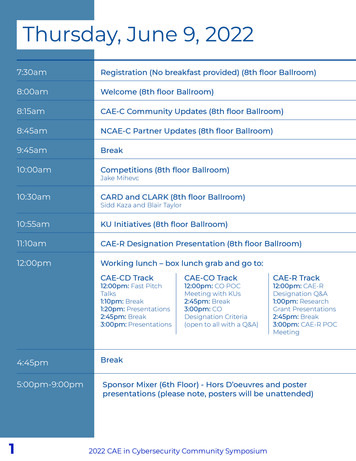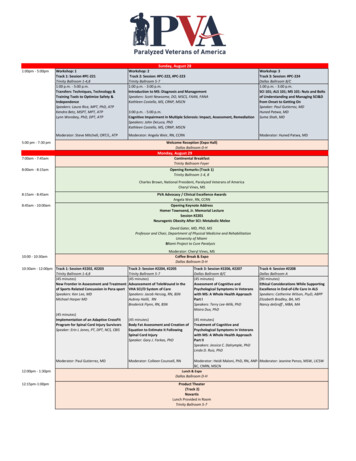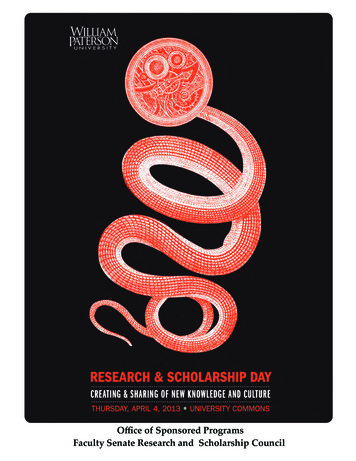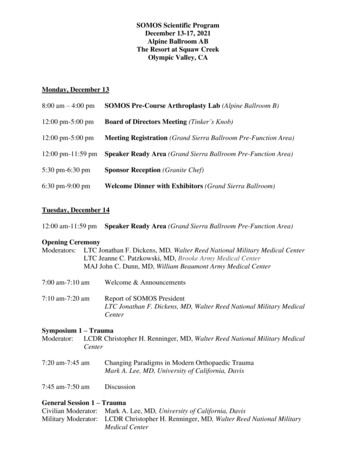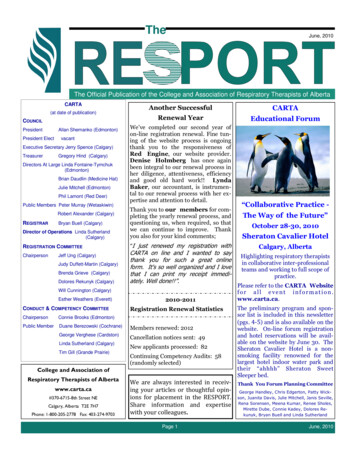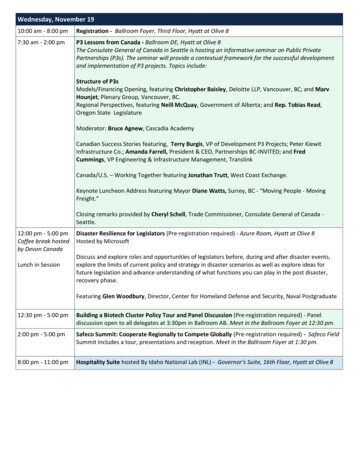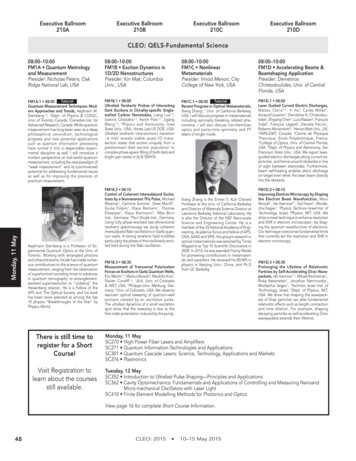
Transcription
Executive Ballroom210AExecutive Ballroom210BExecutive Ballroom210CExecutive Ballroom210DMonday, 11 MayCLEO: QELS-Fundamental Science08:00–10:00FM1A Quantum Metrologyand MeasurementPresider: Nicholas Peters; OakRidge National Lab, USA08:00–10:00FM1B Exciton Dynamics in1D/2D NanostructuresPresider: Kin Mak; ColumbiaUniv., USA08:00–10:00FM1C NonlinearMetamaterialsPresider: Vinod Menon; CityCollege of New York, USA08:00–10:00FM1D Accelerating Beams &Beamshaping ApplicationPresider: DemetriosChristodoulides; Univ. of CentralFlorida, USATutorialFM1A.1 08:00Quantum Measurement Techniques: Modern Approaches and Trends, Aephraim M.Steinberg1,2; 1Dept. of Physics & CQIQC,Univ. of Toronto, Canada; 2Canadian Inst. forAdvanced Research, Canada. While quantummeasurement has long been seen as a deepphilosophical conundrum, technologicalprogress and new potential applicationssuch as quantum information processinghave turned it into a respectable experimental discipline as well. I will introduce amodern perspective on real-world quantummeasurement, including the new paradigm of“weak measurement” and its (controversial)potential for addressing fundamental issuesas well as for improving the precision ofpractical measurement.FM1B.1 08:00Ultrafast Terahertz Probes of InteractingDark Excitons in Chirality-specific Singlewalled Carbon Nanotubes, Liang Luo1,2,Ioannis Chatzakis1,2, Aaron Patz1,2, JigangWang 1,2; 1Physics and Astronomy, IowaState Univ., USA; 2Ames Lab-US DOE, USA.Ultrafast terahertz intra-excitonic transition 6 meV reveals stable quasi-1D manyexciton states that evolve uniquely from apredominant dark exciton population tocomplex phase-space filling of both dark andbright pair states in (6,5) SWNTsTutorialFM1C.1 08:00Recent Progress in Optical Metamaterials,1 1Xiang Zhang ; Univ. of California Berkeley,USA. I will discuss progress in metamaterialsincluding symmetry breaking related phenomena. I will also discuss non-Hermitianoptics and parity-time symmetry and PTlasers of single mode.FM1D.1 08:00Laser Guided Curved Electric Discharges,Matteo Clerici 1,2, Yi Hu 2, Carles Milián 3,Arnaud Couairon3, Demetrios N. Christodoulides4, Zhigang Chen5, Luca Razzari2, FrançoisVidal2, François Légaré2, Daniele Faccio1,Roberto Morandotti2; 1Heriot-Watt Univ., UK;2INRS-EMT, Canada; 3Centre de PhysiqueTheorique, Ecole Polytechnique, France;4College of Optics, Univ. of Central Florida,USA; 5Dept. of Physics and Astronomy, SanFrancisco State Univ., USA. We report laserguided electric discharges along curved trajectories, and hence around obstacles in lineof sight between electrodes. Furthermore,beam self-healing enables direct dischargeon target even when the laser beam directlyhits the obstacle.Aephraim Steinberg is a Professor of Experimental Quantum Optics at the Univ. ofToronto. Working with entangled photonsand ultracold atoms, his lab has made numerous contributions to the science of quantummeasurement, ranging from the observationof superluminal tunneling times to advancesin quantum tomography to entanglementassisted superresolution to “violating” theHeisenberg relation. He is a Fellow of theAPS and The Optical Society, and his workhas been twice selected as among the top10 physics “Breakthroughs of the Year” byPhysics World.There is still time toregister for a ShortCourse!Visit Registration tolearn about the coursesstill available.FM1B.2 08:15Control of Coherent Intersubband Excitations by a Nonresonant THz Pulse, MichaelWoerner1, Carmine Somma1, Drew Morrill1,Giulia Folpini 1, Klaus Reimann 1, ThomasElsaesser 1, Klaus Biermann 2; 1Max BornInst., Germany; 2Paul Drude Inst., Germany.Using fully phase-resolved two-dimensionalterahertz spectroscopy we study coherentintersubband Rabi oscillations in GaAs quantum wells. A strong terahertz field modifiesparticularly the phase of the nonlinearly emitted field during the Rabi oscillation.FM1B.3 08:30Measurement of Transversal PolarizationForces on Excitons in GaAs Quantum Wells,Eric Martin1,3, Markus Borsch2, Mackillo Kira2,Steven Cundiff1,3; 1JILA, Univ. of Colorado& NIST, USA; 2Philipps-Univ. Marburg, Germany; 3Univ. of Colorado, USA. We observeresonant optical tweezing of quantum-wellexcitons created by an excitation pulse.The ultrafast dynamics of a small excitationspot show that the tweezing is due to thefirst-order polarization induced by the pump.Xiang Zhang is the Ernest S. Kuh ChairedProfessor at the Univ. of California Berkeleyand Director of Materials Science Division atLawrence Berkeley National Laboratory. Heis also the Director of the NSF Nano-scaleScience and Engineering Center. He is amember of the US National Academy of Engineering, Academia Sinica and fellow of APS,OSA, AAAS and SPIE. His group’s research inoptical metamaterials was selected by TimesMagazine as Top 10 Scientific Discoveries in2008. In 2014, he was awarded Fitzroy Medalfor pioneering contributions in metamaterials and superlens. He received his BS/MS inphysics in Nanjing Univ., China, and Ph.Dfrom UC Berkeley.FM1D.3 08:30Prolonging the Lifetime of RelativisticParticles by Self-Accelerating Dirac Wavepackets, Ido Kaminer1,2, Mikael Rechtsman1,Rivka Bekenstein1, Jonathan Nemirovsky1,Mordechai Segev1; 1Technion Israel Inst. ofTechnology, Israel; 2Dept. of Physics, MIT,USA. We show that shaping the wavepackets of Dirac particles can alter fundamentalrelativistic effects such as length contractionand time dilation. For example, shapingdecaying particles as self-accelerating Diracwavepackets extends their lifetime.Monday, 11 MaySC270 High Power Fiber Lasers and AmplifiersSC271 Quantum Information-Technologies and ApplicationsSC301 Quantum Cascade Lasers: Science, Technology, Applications and MarketsSC376 PlasmonicsTuesday, 12 MaySC352 Introduction to Ultrafast Pulse Shaping—Principles and ApplicationsSC362 Cavity Optomechanics: Fundamentals and Applications of Controlling and Measuring NanoandMicro-mechanical Oscillators with Laser LightSC410 Finite Element Modelling Methods for Photonics and OpticsView page 16 for complete Short Course Information.48FM1D.2 08:15Improving Electron Microscopy by Shapingthe Electron Beam Wavefunction, MaorMutzafi1, Ido Kaminer2,1, Gal Harari1, Mordechai Segev1; 1Physics, Technion Israel Inst. ofTechnology, Israel; 2Physics, MIT, USA. Weshow a novel technique to enhance resolutionand SNR in electron microscopes - by shaping the quantum wavefunction of electrons.Our technique overcomes fundamental limitsthat currently set the resolution and SNR inelectron microscopy.CLEO: 2015 10–15 May 2015
Executive Ballroom210EExecutive Ballroom210FCLEO: QELSFundamental ScienceExecutive Ballroom210GExecutive Ballroom210HCLEO: Science & Innovations08:00–10:00SM1F Semiconductor LaserPhysicsPresider: Sven Hofling; Univ. ofSt. Andrews., UK08:00–10:00SM1G NanostructuresPresider: Ofer Levi; Univ. ofToronto, Canada08:00–10:00SM1H THz Quantum CascadeLasersPresider: David Burghoff; MIT,USAInvitedFM1E.1 08:00Demonstration of Deterministic PhotonPhoton Interactions with a Single Atom,Serge Rosenblum1, Itay Shomroni1, YuliaLovsky1, Orel Bechler1, Gabriel Guendelman1,Barak Dayan1; 1Weizmann Inst. of Science,Israel. We demonstrate all-optical deterministic photon-atom and photon-photoninteractions with a single Rb atom coupledto high-Q fiber-coupled microresonator. Thisscheme enables all-optical photon routing,passive quantum memory and quantum gatesactivated solely by single photons.InvitedSM1F.1 08:00Quantum Coherent Interactions in RoomTemperature InAs/InP Quantum Dot Amplifiers, Gadi Eisenstein1; 1Technion Israel Inst.of Technology, Israel. We survey the latestadvances in initiation and observation ofquantum coherent interactions in room temperature quantum dot amplifiers operatingat 1550 nm. Single and double pulse FROGmeasurements accompanied by detailedmodeling are described.SM1G.1 08:00Germanium Nanowires as Spectrallyselective Photodetectors in the Visible-toInfrared, Amit Solanki1, Kenneth B. Crozier2,3;1Harvard Univ., USA; 2School of Physics,Univ. of Melbourne, Australia; 3Dept. ofElectrical and Electronic Engineering, Univ.of Melbourne, Australia. We experimentallydemonstrate arrays of vertical Ge nanowiresas spectrally-selective photodetectors at visible to infrared wavelengths. Measurementsreveal that the external quantum efficiencyspectra of fabricated devices vary with theradius of the constituent nanowires.SM1H.1 08:00Selection of Longitudinal Modes in aTerahertz Quantum Cascade Laser viaNarrow-band Injection Seeding, HanondNong 1, Shovon Pal 1, Sergej Markmann 1,Negar Hekmat1, Paul Dean2, Reshma A. Mohandas2, Li Lianhe2, Edmund Linfield2, GilesDavies2, Andreas D. Wieck1, Nathan Jukam1;1Ruhr-Universität Bochum, Germany; 2Univ. ofLeeds, UK. A terahertz quantum cascade laseris injection seeded with narrowband seedpulses generated from a periodically poledlithium niobate crystal. The spectral emissionof the quantum cascade laser is controlled bythe seed spectra.SM1G.2 08:15Ultrafine ferroelectric nanostructure in layered Mg:LiNbO3 thin film, Taichi Okada1,2,Masaki Shimizu 1,2 , Satoshi Horikawa 1,2 ,Takuya Utsugida1,2, Kazufumi Fujii1, SunaoKurimura1,2, Hirochika Nakajima2; 1NationalInst. for Materials Science, Japan; 2WasedaUniv., Japan. We reported a fabrication ofultrafine ferroelectric domain structure with540 nm period into layered Mg-doped/insulator/non-doped LiNbO3.SM1H.2 08:15kW-Peak-Power Terahertz-Wave Parametric Generation and 70 dB-Dynamic-RangeDetection Based on Efficient SurfaceCoupling Configuration, Yuma Takida 1,Takashi Notake1, Kouji Nawata1, Yu Tokizane1,Shin’ichiro Hayashi 1, Hiroaki Minamide 1;1RIKEN, Japan. We have demonstratedkW-peak-power terahertz (THz)-wave parametric generation and 70 dB-dynamic-rangedetection by using efficient surface-couplingconfiguration. The system is capable ofproducing and detecting monochromaticTHz-wave pulses in the wide frequency rangefrom 0.8 to 2.8 THz.SM1G.3 08:30 InvitedTunable Coloration with Flexible HighContrast Metastructures, Li Zhu1, JonasKapraun1, James Ferrara1, Connie J. ChangHansnain1; 1Univ. of California Berkeley, USA.Actively controlling the perceived color ofobjects is highly desirable for a variety ofapplications. We report a new flexible highcontrast metastructure (HCM) with colorbeing varied by stretching the elastomericmembrane.SM1H.3 08:30Broadly-Tunable Room-Temperature Monolithic Terahertz Quantum Cascade LaserSources, Aiting Jiang1, Seungyong Jung1,Yifan Jiang1, Karun Vijayraghavan1, JaehyunKim1, Mikhail A. Belkin1; 1Univ. of Texas atAustin, USA. We report a monolithic terahertzsource made of an array of 10 electricallytunable mid-infrared quantum cascadelasers with intra-cavity terahertz differencefrequency generation. Continuous tunabilitybetween 2 and 4 THz is demonstrated atroom temperature.FM1E.2 08:30Observation of the Nonlinear Phase ShiftDue to Single Post-Selected Photons, AmirFeizpour1, Matin Hallaji1, Greg Dmochowski1,Aephraim M. Steinberg1; 1Physics, Univ. ofToronto, Canada. We implement a strongoptical nonlinearity using electromagnetically-induced transparency in cold atoms, andmeasure the resulting nonlinear phase shiftfor postselected photons. We believe thatthis represents the first direct measurementof the cross-phase shift due to individualphotons.SM1F.2 08:30Crossed Exciton States in Complex Semiconductor Nanostructures, Nina Owschimikow1, Mirco Kolarczik1, Yuecel Kaptan1,Nicolai B. Grosse 1, Ulrike K. Woggon 1;1Technische Universität Berlin, Germany.Based on gain excitation spectra derivedfrom two-color pump-probe experiments,we identify crossed exciton states formedin semiconductor nanostructures of mixeddimensionality and investigate their influenceon the carrier dynamics.Monday, 11 May08:00–10:00FM1E Symposium on Singlephoton Nonlinear Optics IPresider: Jacob Taylor; NIST, USATechnical Digest and Postdeadine PapersAvailable Online Visit www.cleoconference.org Select Access Digest Paper link Use your registration email address and passwordAccess is provided only to full technical attendees.Concurrent sessions are grouped across four pages. Please review all four pages for complete session information.49
Meeting Room211 B/DMonday, 11 MayCLEO: Science &Innovations50Meeting Room212 A/CMeeting Room212 B/DCLEO: Applications& TechnologyMarriottSalon I & IICLEO: Science &Innovations08:00–10:00SM1I Silicon PhotonicsPresider: Bahram Jalali; Univ. ofCalifornia Los Angeles, USA08:00–10:00AM1J Light Sources andDevices for BiomedicalImaging IPresider: Ilya Bezel; KLA-TencorCorp., USA08:00–10:00AM1K Microprocessing UltraFast Processing of DielectriesPresider: Yves Bellouard; EcolePolytechnique Federale deLausanne, Switzerland08:00–10:00SM1L Fiber Sensing andMeasurementPresider: Axel Schulzgen; Univ. ofCentral Florida, USASM1I.1 08:00Plasmonic-organic hybrid (POH) modulators for OOK and BPSK signaling at 40Gbit/s, Argishti Melikyan1, Kira Köhnle1, Matthias Lauermann1, Robert Palmer1, SebastianR. Koeber1, Sascha Muehlbrandt1, PhilippSchindler 1, Delwin Elder 2, Stefan Wolf 1,Wolfgang Heni3, Christian Haffner3, YuriyFedoryshyn3, David Hillerkuss3, Martin Sommer1, Larry Dalton2, Dries VanThourhout4,Wolfgang Freude1, Manfred Kohl1, JuergLeuthold3, Christian Koos1; 1Karlsruher Institut für Technologie, Germany; 2Dept. ofChemistry, Univ. of Washington, USA; 3ETHZürich, Switzerland; 4Ghent Univ. - IMEC,Belgium. We report on plasmonic-organichybrid(POH) phase modulator generating error free (BER 10-10) BPSK signals at 40Gbit/s.In addition, generation and direct detectionof 40Gbit/s OOK signals are discussed using POH Mach-Zehnder modulators on thetransmitter side.InvitedAM1J.1 08:00The Cell Laser, Seok-Hyun A. Yun1,2; 1HarvardMedical School, USA; 2Massachusetts General Hospital, USA. The first demonstrationof a cell laser in 2011 opened new avenuesfor generating coherent light from livingmatters. Here we show progress in this newclass of light sources and demonstrate theirapplications for sensing.InvitedAM1K.1 08:00Ultrashort Pulse Lasers for Precise Processing: Results of a Recent German ResearchInitiative, Stefan Nolte1; 1Friedrich-SchillerUniversità t Jena, Germany. We review results of 10 joint research projects on ultrashortpulse technology. Topics include novel lasersources, reliable components and specializedapplications from eye surgery to processingof semiconductors, carbon fiber reinforcedplastics and metals.InvitedSM1L.1 08:00Novel Technologies for High PrecisionCharacterization of Fibers, Andrew D.Yablon 1; 1Interfiber Analysis, LLC, USA.Optical fiber gain profiling, spectrogrammodal analysis, and interferometric refractive index and residual stress measurementare reviewed. These novel characterizationtechnologies are important for designing,assembling and optimizing fiber-based lasersand amplifiers.AM1J.2 08:30Analysis of Optical Properties of Cell Lasersand Their Use as Biological Sensors, MatjazHumar2,1, Seok-Hyun A. Yun2; 1CondensedMatter Dept., J. Stefan Inst., Slovenia; 2Wellman Center for Photomedicine, Dept. ofDermatology, Harvard Medical School andMassachusetts General Hospital, USA. Weanalyzed single-cell lasers made from different cell types and fluorescent dyes. Twomirrors enclose the cells forming a laser cavity. The different transversal cell laser modesare dependent on cell shape, refractive indexand gain distribution enabling single cellcharacterization and sensing.AM1K.2 08:30High Density Data Storage in Transparent Plastics Using Femtosecond LaserMicrostructuring, Deepak L. Kallepalli 1;1Physics Dept., Univ. of Ottawa, Canada.We report high data storage 66 GB/cm3 inPoly (methylmethacrylate) by utilizing locallyconfined fluorescent data bits fabricated bya femtosecond (fs) laser.SM1L.2 08:30Design and Fabrication of Side-channelPhotonic Crystal Fiber for Surface Enhanced Raman Scattering Applications,Nan Zhang1,2, Georges Humbert3, TianxunGong1,4, Ping Shum1,2, Jean-Louis Auguste3,Zhifang Wu 1,2, Malini Olivo 4,5, Quyen X.Dinh2,6, Lei Wei1; 1School of Electrical andElectronic Engineering, Nanyang Techonogical Univ., Singapore; 2CINTRA CNRS/NTU/THALES, Singapore; 3Univ. of Limoges/CNRS, France; 4Bio-Optical Imaging Group,Singapore Bioimaging Consortium (SBIC),A*STAR, Singapore; 5School of Physics, National Univ. of Ireland, Ireland; 6R&T Dept.,Thales Solutions Asia Pte Ltd, Singapore. Wedemonstrate a side-channel photonic crystalfiber for surface enhanced Raman scatteringapplications. A low detection concentrationof 5 pM 4-aminothiophenol solution and anaccumulative effect of Raman signal alongthe fiber length are achieved.SM1I.2 08:15Ultra-Compact Hybrid Silicon-VO2 Electroabsorption Optical Switch, Arash Joushaghani1, Junho Jeong1, Suzanne Paradis2,David Alain2, J. Stewart Aitchison1, Joyce K.Poon1; 1Electrical and Computer Engineering, Univ. of Toronto, Canada; 2DefenceResearch and Development Canada - Valcartier, Canada. A 1 μm-long hybrid Si-VO2electroabsorption switch with integratedelectrical contacts is demonstrated. A recordextinction ratio of 12 dB/μm is achievedover a bandwidth of 100 nm with a powerdissipation of 2.55 mW.SM1I.3 08:30Hybrid Silicon Ring Laser with Unidirectional Emission, Wesley D. Sacher1, MichaelDavenport2, Martijn J. Heck2, Jared Mikkelsen1, Joyce K. Poon1, John Bowers2; 1Dept.of Electrical and Computer Engineering, Univ.of Toronto, Canada; 2Dept. of Electrical andComputer Engineering, Univ. of California atSanta Barbara, USA. A hybrid silicon ring laserin which the counter-clockwise circulatingpower is coupled into the clockwise mode isdemonstrated. Unidirectional clockwise laseroutput is achieved with a suppression ratioof 19 dB over the counter-clockwise mode.CLEO: 2015 10–15 May 2015
MarriottSalon IIIMarriottSalon IVMarriottSalon V & VIMarriottWillow Glen I-IIICLEO: Science & Innovations08:00–09:45SM1N Symposium on RemoteAtmospheric Lasing IPresider: Pavel Polynkin; Univ. ofArizona, USA08:00–10:00SM1O AdvancedSpectroscopic TechniquesPresider: Scott Howard; Univ. ofNotre Dame, USA08:00–10:00SM1P Few-cycle InfraredSourcesPresider: Nobuhisa Ishii; Institutefor Solid State Physics, JapanTutorialSM1M.1 08:00Optical and Hybrid Signal Processing,Stojan Radic1; 1Univ. of California, San Diego,USA. Physics and implementation of opticalsignal processing in communication andsensing links is introduced. Hybrid processingschemes capable of interfacing with high-ratenetwork traffic and electronic backplane aredescribed and illustrated using applicationexamples.InvitedSM1N.1 08:00Remote Backward-Propagating Lasing ofNitrogen and Oxygen in Air, Arthur Dogariu1, Richard Miles1; 1Princeton Univ., USA. Wepresent the latest developments in remoteatmospheric air lasing. Stimulated emissioninduced by two-photon atomic excitation following molecular dissociation creates robustcoherent emission in the backwards direction.SM1O.1 08:00Analysis of Trace Gas Mixtures Using anExternal Cavity Quantum Cascade LaserSensor, Mark C. Phillips1, Matthew S. Taubman1, Brian Brumfield1, Jason Kriesel2; 1PacificNorthwest National Lab, USA; 2Opto-Knowledge Systems Inc., USA. We measure andanalyze mixtures of trace gases at ppb-ppmlevels using an external cavity quantum cascade laser sensor with a 1-second responsetime. Accurate spectral fits are obtained inthe presence of overlapping spectra.SM1P.1 08:00A Compact Single Cycle Driver for StrongField Applications based on a Self-compression in a Kagome Fiber, Guangyu Fan1,Tadas Balciunas1, Stefan Hässler1, CoralieFourcade Dutin 2, Tobias Witting 3, Aleksandr Voronin4, Aleksei Zheltikov4,5, FrédéricGérôme2, Gerhard Paulus6, Andrius Baltuska1,Fetah Benabid2; 1Vienna Univ. of Technology,Photonics Inst., Austria; 2Univ. de Limoges,GPPMM group, Xlim Research Inst., France;3Imperial College London, Blackett Lab,UK; 4M.V. Lomonosov Moscow State Univ.,Physics Dept., International Laser Center,Russia; 5Texas A & M Univ., College StationTexas, Dept. of Physics and Astronomy, USA;6Universität Jena, Institut fuer Optik undQuantenelektronik, Germany. We report onKagome fiber based self-compression of100 µJ IR pulses to single cycle duration anddemonstrate HHG in an integrated schemewhich allows a compact isolated attosecondXUV source implementation above 50 eV.SM1O.2 08:15Fundamental Limits in Chirped Laser Dispersion Spectroscopy, Genevieve Plant1,Andreas Hangauer 1 , Gerard Wysocki 1 ;1Princeton Univ., USA. We present performance analysis of chirped laser dispersionspectroscopy (CLaDS) under shot noiselimited conditions. A comparison to directlaser absorption spectroscopy (DLAS) isalso provided.SM1P.2 08:15Mid-IR 0.4TW Pulses Achieved ThroughHollow-Core Fiber Compression, VincentCardin 1, Nicolas Thiré 1, Vincent Wanie 1,Samuel Beaulieu1, François Légaré1, BrunoE. Schmidt1; 1INRS-EMT, Canada. By employing hollow-core fiber compression using astretched flexible fiber, we achieved 2-cyclespulses centered on 1.8µm with more than5mJ energy per pulse.InvitedSM1O.3 08:30Mid-IR Quantum Cascade Lasers as an Enabling Technology for Analytical Chemistry,Christian Kristament1, Markus Brandstetter1,Andreas Schwaighofer 1, Mirta Alcaraz 1,Bernhard Lendl1; 1Chemical Technologiesand Analytics, Vienna Univ. of Technology,Austria. An overview on the state of the arton the analysis of liquids by QCLs is givenwith special focus on the determination ofsecondary structure elements in aqueousprotein solutions using an EC-QCL system.SM1P.3 08:30Broadband ZGP OPA Pumped by Femtosecond Ho:YAG Chirped Pulse Amplifier,Pavel Malevich2, Tsuneto Kanai2, GregoryGitzinger1, Raman Maksimenka1, Nicolas Forget1, Andrius Baltuska2,3, Audrius Pugzlys2,3;1Fastlite, France; 2Vienna Univ. of Technology, Austria; 3Center for Physical Sciences& Technology, Lithuania. We demonstratea broadband parametric amplifier at 6 µmdriven by a femtosecond 2.1µm Ho:YAGchirped-pulse amplifier. The scheme offersan all-in-one solution for seeding, pumpingand phase stabilization of few-cycle pulses inZnGeP2 and similar mid-IR crystals.Stojan Radic graduated from the Inst. ofOptics, Univ. of Rochester, in 1995 and hassubsequently served at Corning and BellLaboratories. After leaving Bell Laboratories,he was a Nortel Chair at Duke Univ. Currentlyhe is a professor and a Director of the Photonics System Laboratory at Qualcomm Inst. atthe Univ. of California San Diego. Radic is aFellow of The Optical Society and serves asan editor with IEEE Photonics TechnologyLetters and Optics Express Journals. Radic’slaboratory currently pursues national projectsin coherent communications, advancedsignal processing and unconventional medical imaging.InvitedSM1N.2 08:30Experiments on Deep-UV Two-photonPumping of Fluorescence and StimulatedEmission in Oxygen and Nitrogen Atoms inFlames, Joakim Bood1, Marcus Aldén1; 1LundUniv., Sweden. Flame experiments usingstimulated emission in oxygen and nitrogenatoms induced by 2-photon excitation arereviewed and discussed in terms of today’sdevelopment of remote sensing conceptsbased on backward lasing in air.Concurrent sessions are grouped across four pages. Please review all four pages for complete session information.Monday, 11 May08:00–09:45SM1M Parametric ProcessingPresider: Francesca Parmigiani;Univ. of Southampton, UK51
Executive Ballroom210AExecutive Ballroom210BExecutive Ballroom210CExecutive Ballroom210DCLEO: QELS-Fundamental ScienceFM1A Quantum Metrologyand Measurement—ContinuedFM1B Exciton Dynamicsin 1D/2D Nanostructures—ContinuedFM1C NonlinearMetamaterials—ContinuedMonday, 11 MayFM1B.4 08:45Ultrafast Modulation of Strong LightMatter Coupling, Christoph Lange1, Emiliano Cancellieri2, Lee A. Rozema3, RocksonChang 3 , Shreyas Potnis 3 , Aephraim M.Steinberg3, Mark Steger4, David W. Snoke4,Loren N. Pfeiffer5, Kenneth W. West5, AlexHayat6; 1Universität Regensburg, Germany;2Univ. of Sheffield, UK; 3Dept. of Physics, Centre for Quantum Information and QuantumControl, and Inst. for Optical Sciences, Univ.of Toronto, Canada; 4Dept. of Physics andAstronomy, Univ. of Pittsburgh, USA; 5Dept.of Electrical Engineering, Princeton Univ.,USA; 6Dept. of Electrical Engineering, Technion, Israel. We modulate strong couplingin a GaAs/AlGaAs microcavity by transientlydecoupling exciton and cavity through theoptical Stark effect induced by intense, reddetuned laser pulses. Pulses longer (1500 fs)and shorter (225 fs) than the Rabi cycle timeof 500 fs yield distinctly different line shapes.52FM1D Accelerating Beams& Beamshaping Application—ContinuedFM1D.4 08:45Accelerating Self-Imaging: the Airy-TalbotEffect, Yaakov Lumer 1, Lee Drori 1, YaovHazan1, Mordechai Segev1; 1Physics Dept.,Technion Israel Inst. of Technology, Israel.We present self-imaging of optical wavesalong curved trajectories, theoretically andexperimentally. Unlike the Talbot effect, thefield wave need not be periodic. Paraxially,self-imaging persists indefinitely, while nonparaxially is limited by overall bending angle.FM1A.2 09:00Experimentally Quantifying the Advantages of Weak-Values-Based Metrology,Gerardo Viza1,2, Julian Martinez1,2, GabrielAlves3, Andrew N. Jordan1,2, John Howell1,2;1Dept. of Physics and Astronomy, Univ. ofRochester, USA; 2The Center for Coherenceand Quantum Optics, Univ. of Rochester,USA; 3Instituto de Fisica, UniversidadeFederal do Rio de Janeiro, Brazil. We measure optical beam deflections both using aweak-values technique and by focusing. Byintroducing controlled modulations, the WVToutperforms focusing. Post-selecting on 1\%of the photons, we obtain 99\% of the available Fisher information.FM1B.5 09:00Coherent Control of Correlation Transportbetween Semiconductor Quantum Wells,Osmo Vänskä1,2, Ilkka Tittonen2, Stephan W.Koch1, Mackillo Kira1; 1Philipps-UniversitätMarburg, Germany; 2Aalto Univ., Finland.Terahertz control of semiconductor excitations is analyzed theoretically in a doublequantum-well by theoretical modeling. Theresults demonstrate that selective transportof electrons, excitons and even pure correlations is realizable in present-day experiments.FM1C.2 09:00Third-Harmonic Generation from SiliconOligomers and Metasurfaces, Maxim R.Shcherbakov3, Dragomir N. Neshev1, BenHopkins1, Alexander S. Shorokhov3, IsabelleStaude1, Elizaveta V. Melik-Gaykazyan3, Andrey Miroshnichenko1, Igal Brener2, Andrey A.Fedyanin3, Yuri S. Kivshar1; 1Nonlinear Physics Centre, Research School of Physics andEngineering, The Australian National Univ.,Australia; 2Center for Integrated Nanotechnologies, Sandia National Lab, USA; 3Facultyof Physics, Lomonosov Moscow State Univ.,Russia. Third-harmonic generation spectroscopy of silicon oligomers and metasurfacesreveals the nonlinear spectra reshaping withelectric and magnetic dipolar Mie-typeresonances and up-conversion increase bytwo orders of magnitude as compared tothe bulk silicon.FM1D.5 09:00Optical Wavepackets Overcoming Gravitational Effects, Rivka Bekenstein 1, RanSchley1, Maor Mutzafi1, Carmel Rotschild1,Mordechai Segev1; 1Technion Israel Inst. ofTechnology, Israel. We find specific wavepackets that overcome analogue gravitationalphenomena due to the complex interplaybetween interference effects and variousoptical gravitational effects, and demonstratethem in experiments with nonlocal nonlinearinteractions.FM1A.3 09:15Particle vs. Mode Entanglement in OpticalQuantum Metrology, Nicolas Quesada1,Jaspreet Sahota1; 1Univ. of Toronto, Canada.We present a constructive proof of the factthat mode entanglement is not necessary foroptical quantum enhanced metrology (QEM)but particle entanglement is. We provide aparticle entanglement witness that detectsall path symmetric states useful for QEM ina Mach-Zender interferometer.FM1B.6 09:15Quantum Optics with Dropletons, MartinMootz1, Mackillo Kira1, Stephan W. Koch1,Andrew E. Almand-Hunter2,3, Kai Wang2,Steven Cundiff2,3; 1Dept. of Physics, PhilippsUniv. Marburg, Germany; 2JILA, Univ. ofColorado and National Inst. of Standards andTechnology, USA; 3Dept. of Physics, Univ. ofColorado, USA. Dropletons are highly correlated quasiparticles, recently found in GaAsquantum wells. We demonstrate that theycan be controlled by adjusting light source’squantum fluctuations and that their sizegrows with increasing temperature.FM1C.3 09:15Multipolar analysis of linear and nonlinearunidirectional response from plasmonicdimers, Ekaterina Poutrina2,1, AugustineUrbas2; 1UES, Inc., USA; 2Air Force ResearchLab, USA. We develop the retrieval procedure for linear and nonlinear polarizabilitiesof plasmonic nanodimers and presentexamples of unidirectional scattering andnonlinear unidirectional generation from suchgeometries. Related effective parameters ofperiodic dimer arrangements are discussed.FM1D.6 09:15Three-Dimensional Abruptly AutofocusingOptical Wave Packet, Qian Cao2,3, ChenchenWan2,1, Xin Huang2, Andy Chong2,4; 1DESY,Germany; 2Electro-Optics Program, Univ. ofDayton, USA; 3FS-CFEL-2, Center of FreeElectron Laser Science, Germany; 4Physics,Univ. of Dayton, USA. We generate a threedimensional (3D) autofocusing wave packetby combining counter-propagating Airypulses and an Airy ring beam. A 3D profilemeasurement reveals unique 3D autofocusing of such wave packet in a linear medium.CLEO: 2015 10–15 May 2015
Executive Ballroom210EExecutive Ballroom210FCLEO: QELSFundamental ScienceExecutive Ballroom210GExecutive Ballroom210HCLEO: Science & InnovationsFM1E Symposium on Singlephoton Nonlinear Optics I—ContinuedSM1F Semiconductor LaserPhysics—ContinuedSM1G Nanostructures—ContinuedFM1E.3 08:45How a Single Photon Can Act Like ManyPhotons, Matin Hallaji1, Amir Feizpour1, GregDmochowski1, Josiah Sinclair1, AephraimM. Steinberg1; 1Physics, Univ. of Toronto,Canada. The weak nonlinear effect of asingle photon on a probe beam is amplifiedby postselecting on a rare final state (“WVA”effect). The resulting cross-phase shift is upto five times greater than the usual singlephoton phase shift.SM1F.3 08
Leeds, UK. A terahertz quantum cascade laser is injection seeded with narrowband seed pulses generated from a periodically poled lithium niobate crystal. The spectral emission of the quantum cascade laser is controlled by the seed spectra. SM1G.2 08:15 Ultrafine ferroelectric nanostructure in lay-ered Mg:LiNbO 3 thin film, Taichi Okada1,2,
